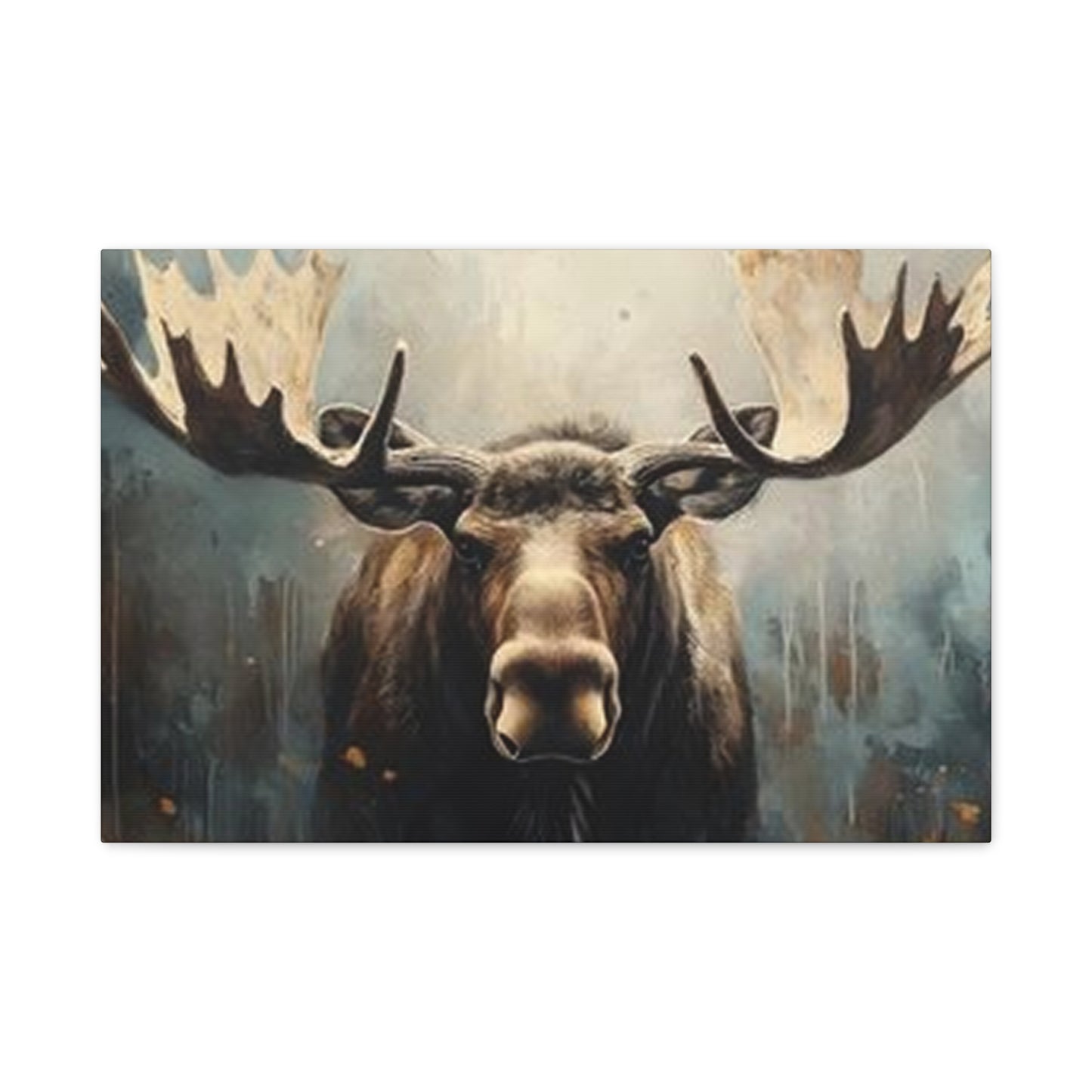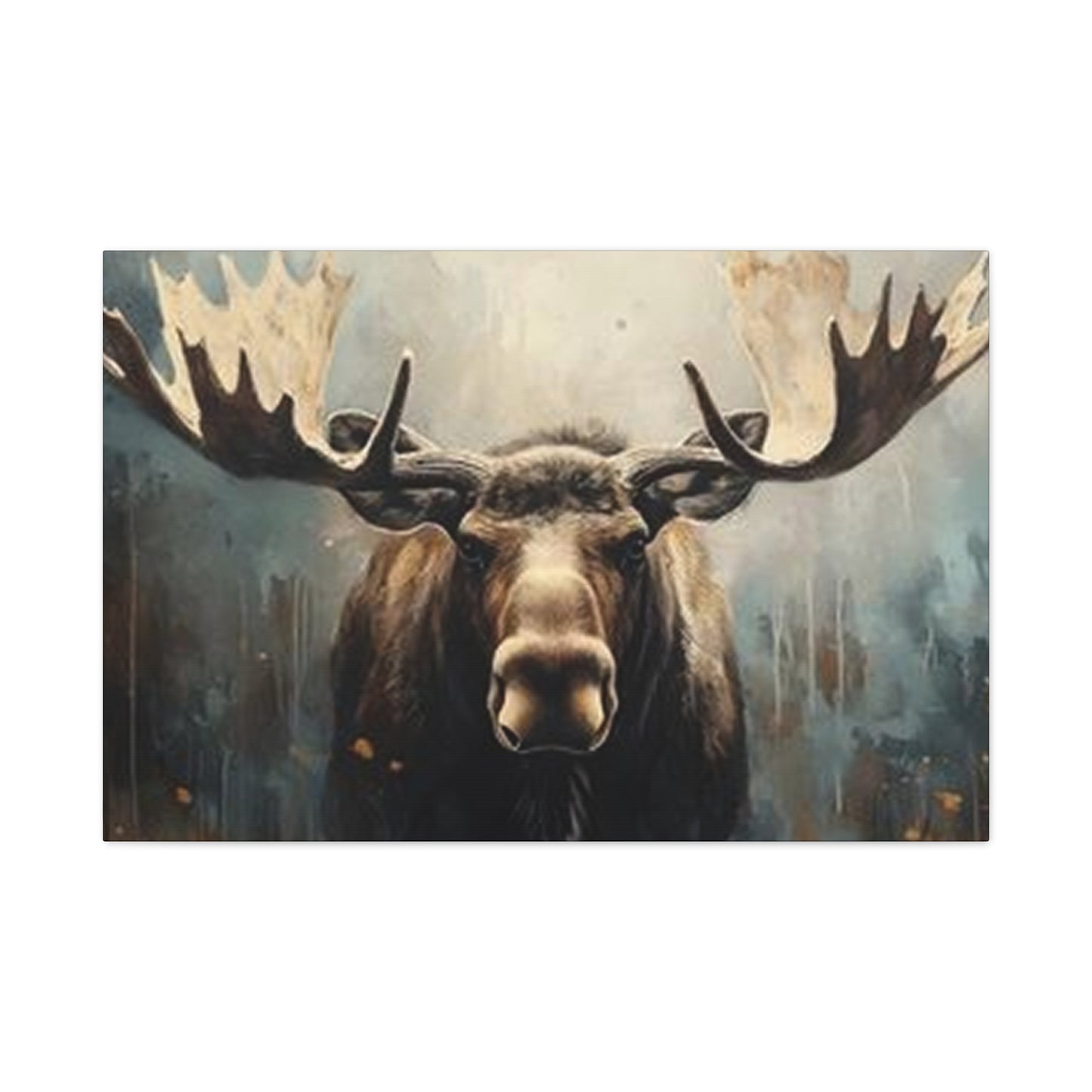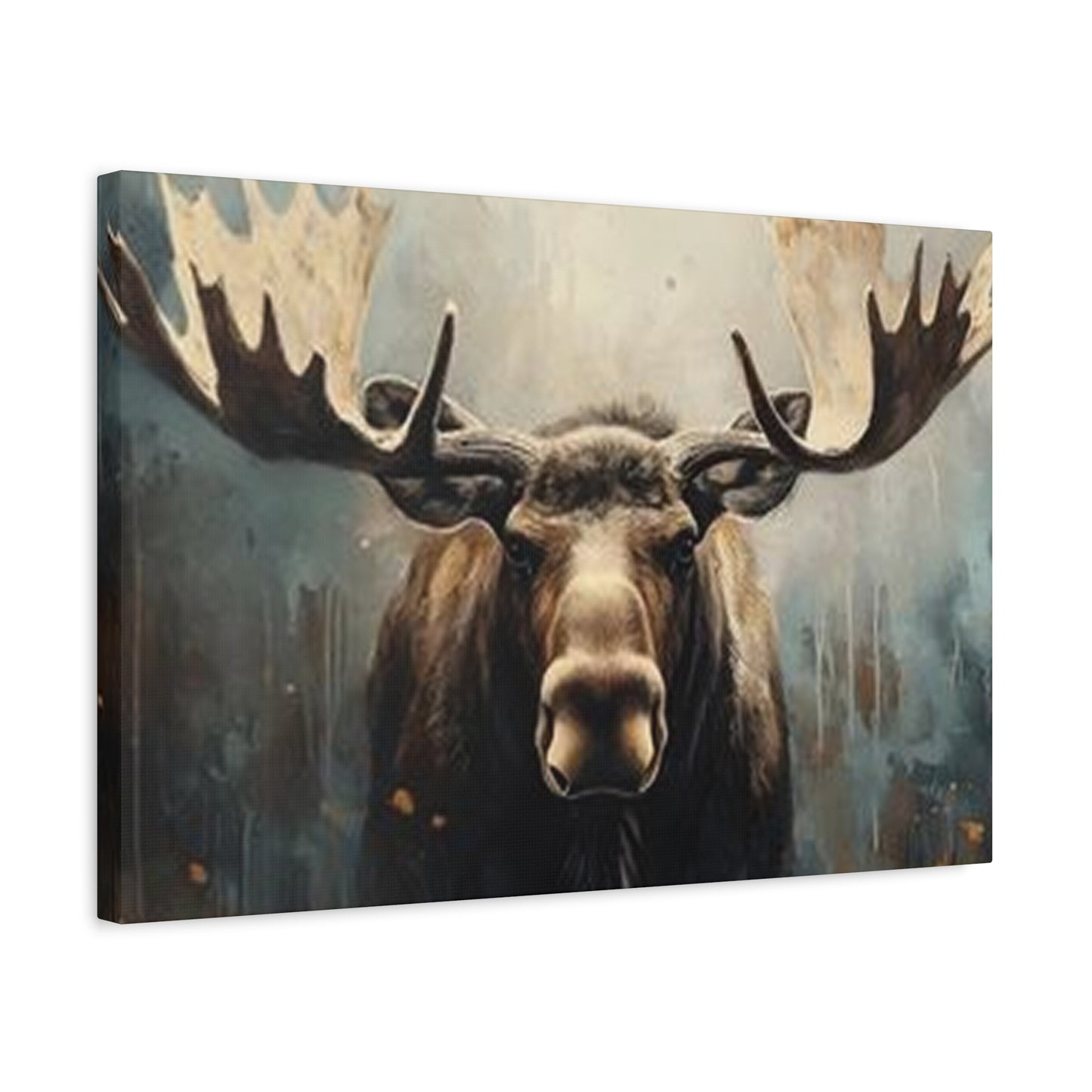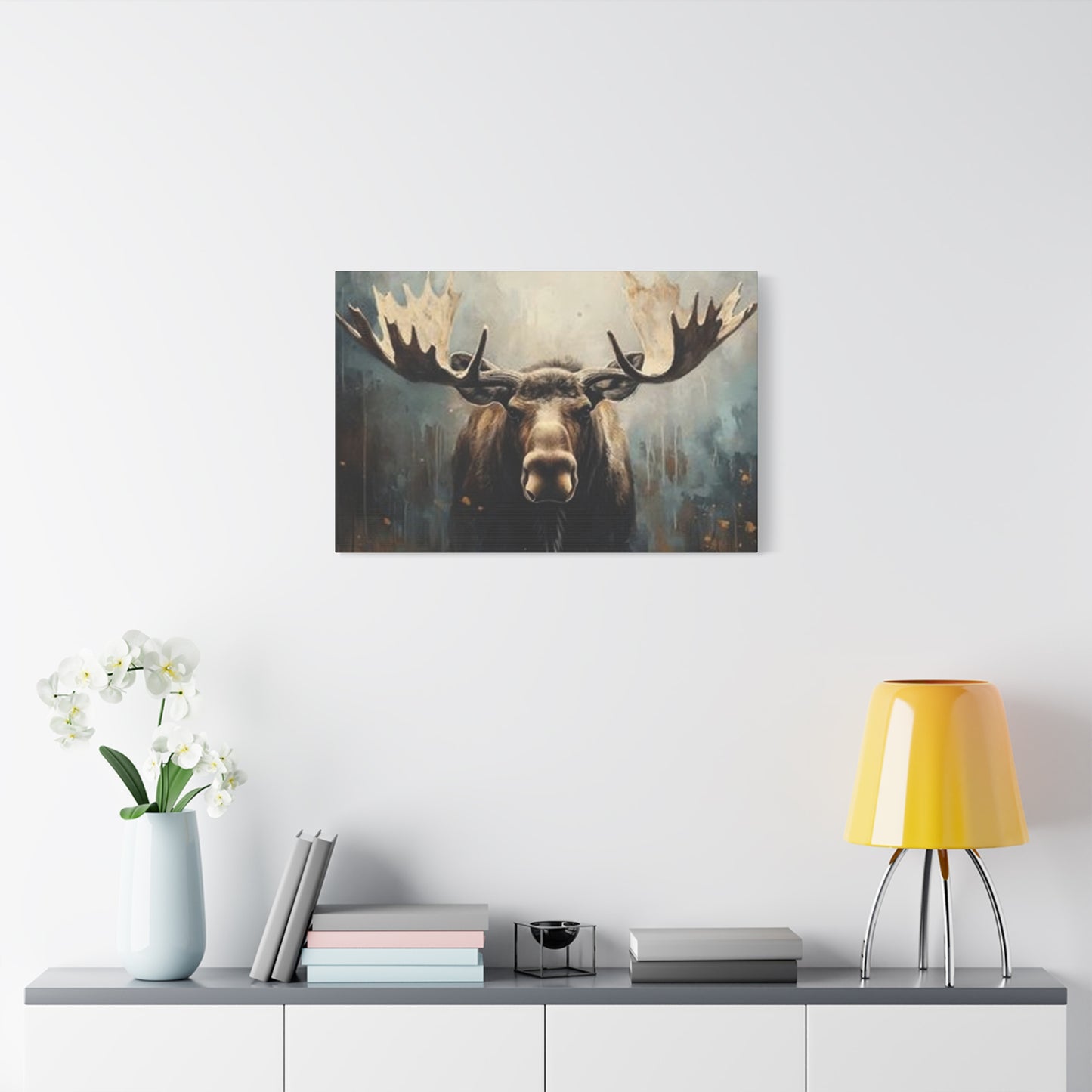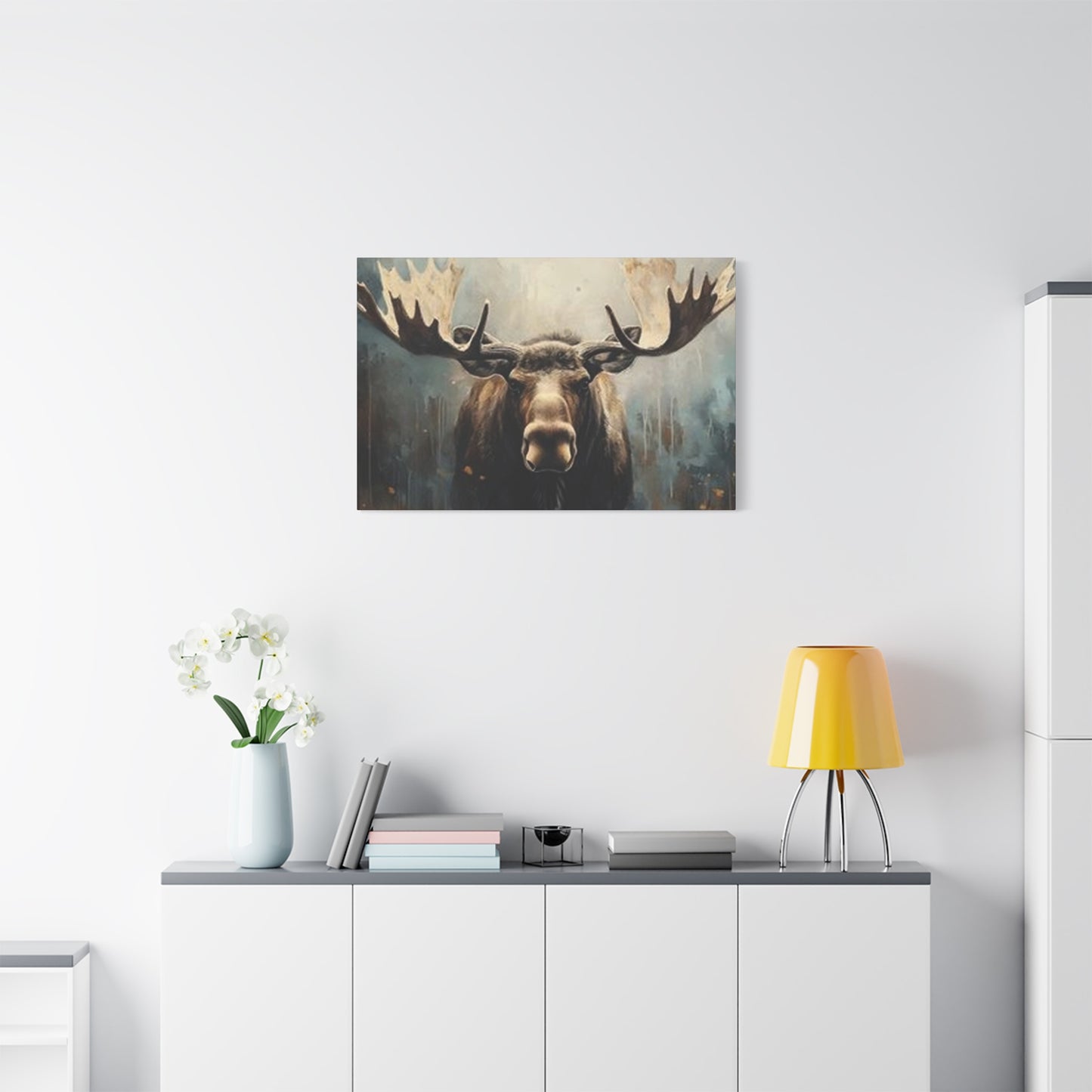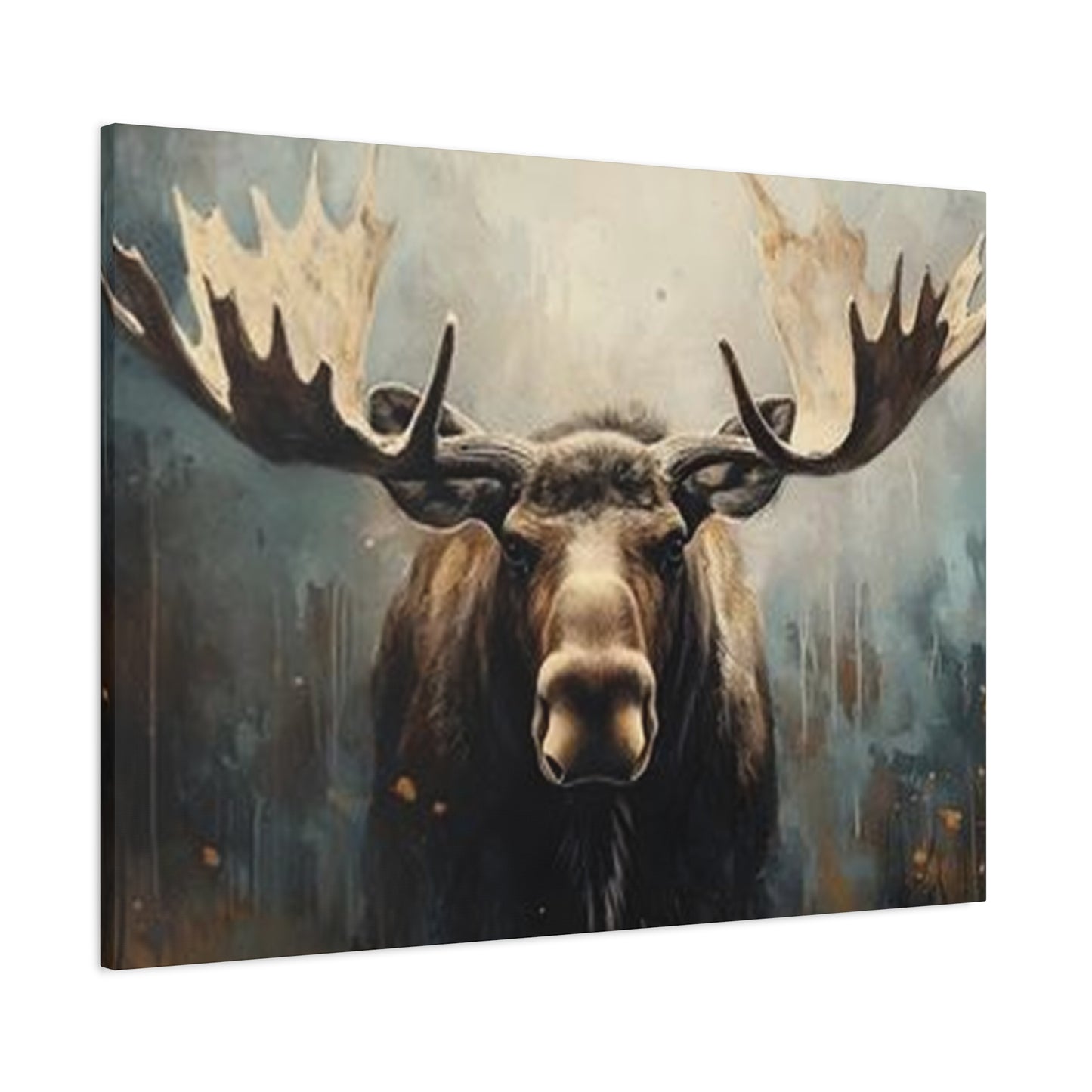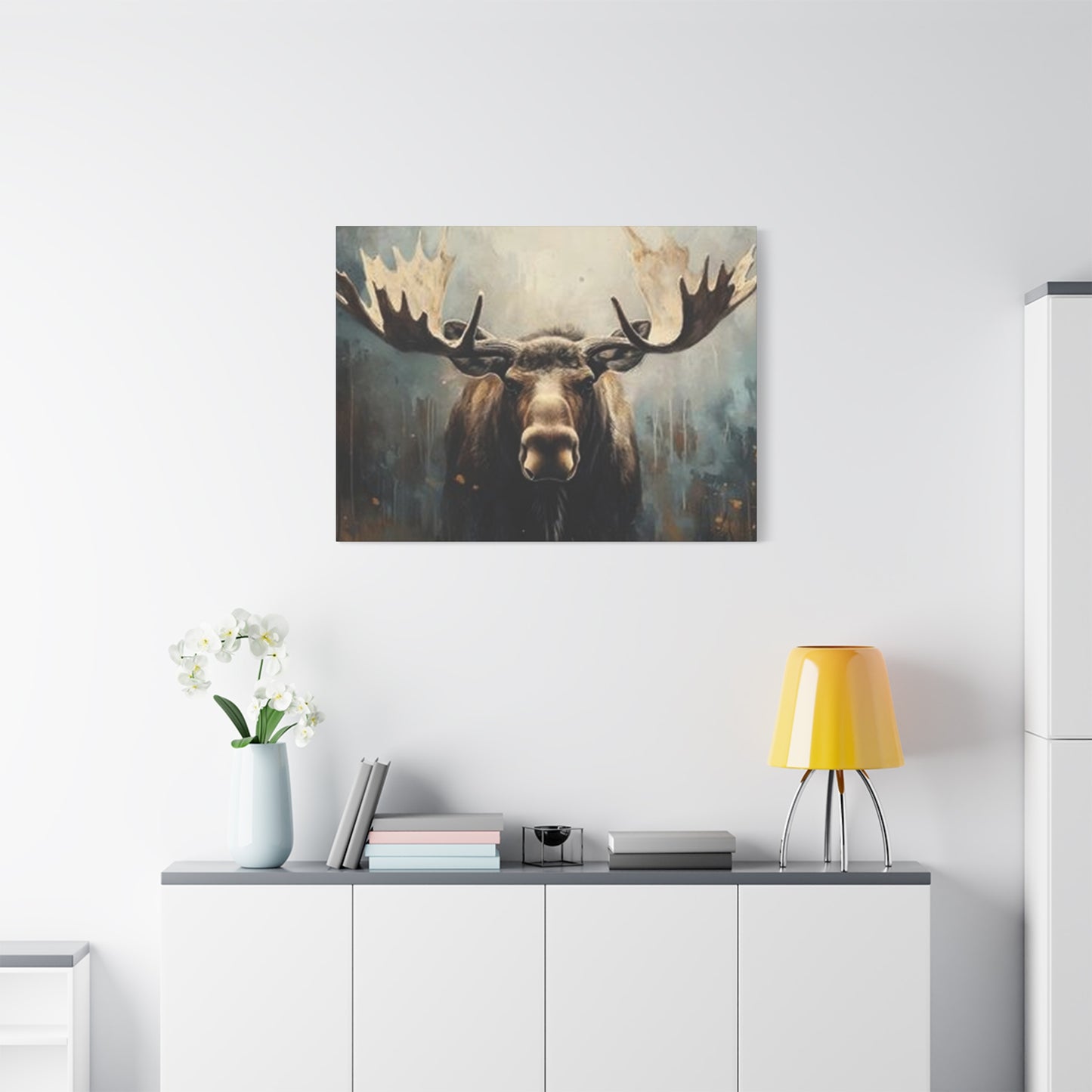Large Moose Painting Wall Art & Canvas Prints
Large Moose Painting Wall Art & Canvas Prints
Couldn't load pickup availability
Majestic Wildlife Canvas: How a Large Moose Painting Wall Art Brings Natural Grandeur Into Your Living Space
The presence of wildlife imagery within residential and commercial environments has experienced remarkable growth over recent decades. Among the most captivating choices for interior embellishment stands the magnificent representation of North American fauna through oversized canvas displays. A large moose painting wall art serves as more than mere decoration; it functions as a powerful statement piece that transforms mundane spaces into extraordinary sanctuaries of natural beauty. These impressive visual presentations capture the essence of wilderness while simultaneously providing aesthetic sophistication that complements various design philosophies.
The Captivating Essence Behind Selecting Oversized Wildlife Canvas Representations
When individuals contemplate adding substantial artistic elements to their dwellings, the selection process involves numerous considerations beyond simple aesthetic preference. The decision to incorporate a large moose painting wall art into residential or professional environments reflects deeper connections to nature, personal identity, and spatial transformation goals. Wildlife imagery possesses inherent qualities that resonate with human consciousness on multiple levels, triggering emotional responses that range from tranquility to inspiration.
The moose, specifically, represents strength, solitude, and resilience—characteristics that many individuals aspire to embody in their personal lives. This magnificent creature, often depicted in moments of quiet dignity against vast wilderness backdrops, communicates messages that transcend verbal language. The sheer scale of properly executed wildlife representations creates focal points that command attention without overwhelming existing decorative schemes.
Residential spaces benefit tremendously from the introduction of substantial artistic statements. Bare walls diminish the warmth and character of otherwise well-appointed rooms, creating feelings of incompleteness that subconsciously affect occupants' comfort levels. A large moose painting wall art addresses this deficiency while simultaneously introducing organic elements that counterbalance the artificial aspects of constructed environments.
Dimensional Considerations When Incorporating Substantial Canvas Displays
The physical dimensions of artwork significantly influence its impact within designated spaces. Understanding appropriate sizing ensures that your selected piece enhances rather than overwhelms your environment. A large moose painting wall art typically measures between forty-eight and seventy-two inches across its longest dimension, though variations exist to accommodate diverse spatial requirements.
Room proportions dictate ideal artwork dimensions. Spacious living areas with high ceilings naturally accommodate grander presentations, while more intimate spaces require careful calculation to maintain visual balance. The general principle suggests that artwork should occupy approximately two-thirds to three-quarters of available wall space above furniture pieces to achieve harmonious proportions.
Vertical versus horizontal orientations create distinctly different visual effects. Horizontal configurations emphasize breadth and expansiveness, making rooms appear wider while drawing the eye laterally across the composition. Vertical arrangements create impressions of height, making ceilings seem elevated while encouraging upward visual movement through the space.
Multiple panel installations offer dynamic alternatives to single-piece presentations. Triptych and multi-panel arrangements of a large moose painting wall art distribute visual weight across broader areas while creating rhythmic patterns that guide viewers' attention throughout the composition. This approach works particularly well in extended spaces such as hallways or above sectional furniture arrangements.
Color Palette Selection and Its Influence on Atmospheric Qualities
The chromatic composition of wildlife artwork profoundly affects the emotional atmosphere within inhabited spaces. Color theory principles govern how various hues interact with surrounding elements while influencing occupants' psychological states. A large moose painting wall art rendered in earth tones creates vastly different ambient qualities compared to pieces featuring vivid, saturated palettes.
Neutral color schemes featuring browns, grays, and muted greens provide versatile options that integrate seamlessly with diverse decorative approaches. These understated palettes allow the subject matter itself to command attention while maintaining compatibility with existing furnishings and architectural elements. Such pieces function as anchoring elements that ground more eclectic decorative choices without creating visual conflicts.
Dramatic contrast treatments employing deep shadows against bright highlights generate powerful visual impact that immediately captures attention. These bold presentations work exceptionally well in minimalist environments where fewer competing elements allow the artwork to dominate visual hierarchy. The interplay between light and darkness within the composition creates depth perception that adds dimensional quality to flat surfaces.
Seasonal variations in color temperature offer another consideration for discerning selectors. Cool tones suggesting winter landscapes evoke different emotional responses than warm autumn palettes featuring golden aspens and russet undergrowth. A large moose painting wall art depicting spring or summer scenes introduces lighter, more refreshing qualities that energize spaces during darker months.
Artistic Styles and Rendering Approaches for Wildlife Imagery
Wildlife representations span an extensive spectrum of artistic interpretations, each conveying distinct aesthetic messages. Understanding various stylistic approaches helps selectors identify pieces that authentically reflect their personal sensibilities while complementing existing environmental characteristics.
Photorealistic renderings capture minute details with painstaking accuracy, creating almost trompe-l'oeil effects that blur boundaries between representation and reality. These meticulous presentations appeal to individuals who appreciate technical mastery and naturalistic depictions. The extraordinary detail work invites prolonged examination, revealing new subtleties with each viewing.
Impressionistic interpretations sacrifice precise detail in favor of capturing essential qualities through loose brushwork and suggestive forms. These pieces convey emotional essence rather than literal accuracy, creating atmospheric qualities that resonate on visceral levels. A large moose painting wall art executed in impressionistic style offers softer, more dreamlike qualities that introduce contemplative tranquility into living environments.
Contemporary abstract approaches deconstruct wildlife subjects into geometric forms and unconventional color relationships. These bold reinterpretations challenge conventional representation while maintaining recognizable connections to their subjects. Such pieces appeal to individuals seeking conversation-starting statements that demonstrate artistic adventurousness.
Traditional realism occupies middle ground between photographic precision and interpretive license. These balanced approaches capture recognizable likeness while incorporating artistic enhancement that elevates subjects beyond mere documentation. This accessible style appeals to broad audiences while maintaining sufficient sophistication for discriminating collectors.
Material Composition and Construction Quality Indicators
The physical substrate and construction methods employed in creating oversized artwork significantly influence both appearance and longevity. Understanding material characteristics enables informed selection decisions that balance aesthetic preferences with practical durability considerations.
Canvas remains the predominant substrate for substantial paintings due to its textile flexibility and traditional associations with fine artwork. Cotton canvas offers affordability and adequate durability for most residential environments, while linen provides superior longevity and texture for premium presentations. The weave density affects both strength and surface appearance, with tighter weaves supporting finer detail work.
Wood panel substrates provide rigid alternatives to flexible canvas, eliminating concerns about sagging or warping over time. These solid surfaces accept paint differently than textile substrates, creating distinct textural qualities that some artists prefer. However, weight considerations become significant with larger dimensions, potentially complicating mounting procedures.
Print reproduction methods vary considerably in quality and permanence. Giclée printing utilizing archival inks on museum-quality substrates produces remarkably faithful reproductions that resist fading for decades under proper conditions. This process enables wider access to sought-after imagery while maintaining high standards. A large moose painting wall art reproduced through premium giclée methods rivals hand-painted originals in visual impact while offering improved consistency.
Protective coatings shield underlying imagery from environmental degradation. UV-resistant varnishes prevent color shifting caused by sunlight exposure, while moisture-resistant sealants guard against humidity damage in bathrooms or kitchens. These invisible protections extend artwork lifespan significantly without altering intended appearance.
Strategic Placement Principles for Maximizing Visual Impact
The location selected for displaying substantial artwork determines its effectiveness as a decorative element. Thoughtful positioning considers multiple factors including lighting conditions, viewing angles, and relationship to surrounding furnishings and architectural features.
Eye-level centering represents the fundamental positioning principle, placing the artwork's vertical center approximately fifty-seven to sixty inches from floor level—the average human eye height. This positioning ensures comfortable viewing without neck strain while maintaining appropriate visual balance. Adjustments may be necessary when furniture placement affects viewing positions or when ceilings vary significantly from standard heights.
Above-furniture placement requires specific spacing calculations to maintain visual cohesion. A large moose painting wall art positioned above sofas or console tables should hang approximately six to twelve inches above the furniture's top surface, creating visual connection without appearing to float disconnected from the furnishing below. This spacing allows both elements to function as unified compositions rather than competing entities.
Lighting conditions dramatically influence artwork appearance and visibility. Natural illumination from windows creates dynamic viewing experiences as changing daylight qualities alter perceived colors and contrast throughout daily cycles. However, direct sunlight causes significant damage over time, necessitating protective measures such as UV-filtering window treatments or strategic positioning away from intense exposure.
Artificial illumination offers controlled alternatives to unpredictable natural light. Dedicated picture lights mounted above or below artwork provide focused illumination that enhances visibility while creating dramatic shadows that emphasize texture and dimensionality. Track lighting systems offer adjustable options that accommodate changing arrangements, while recessed fixtures maintain clean, uncluttered appearances in contemporary spaces.
Harmonizing Wildlife Artwork With Existing Interior Design Schemes
Successfully incorporating substantial wildlife representations requires consideration of existing decorative elements and overall design philosophies. Rather than creating jarring disconnections, properly selected and positioned pieces enhance and reinforce established aesthetic directions.
Rustic environments naturally accommodate wildlife imagery through shared emphasis on organic materials and natural themes. A large moose painting wall art complements exposed timber beams, stone fireplace surrounds, and leather furnishings through thematic consistency. However, avoiding excessive thematic redundancy prevents spaces from feeling overly literal or staged, like showroom vignettes rather than authentic living environments.
Contemporary minimalist spaces benefit from the textural richness and organic forms that wildlife artwork introduces. The juxtaposition between clean-lined furnishings and detailed natural imagery creates dynamic visual interest while maintaining the uncluttered aesthetic that defines contemporary design. Selecting pieces with substantial negative space prevents overwhelming the intentional simplicity that characterizes this approach.
Transitional design philosophies blending traditional and contemporary elements find ideal partners in wildlife representations that balance realistic rendering with artistic interpretation. These hybrid approaches mirror the transitional design ethos of respecting convention while embracing fresh perspectives. The inherent timelessness of wildlife subjects transcends temporary trends, providing enduring appeal that justifies substantial investments.
Eclectic environments assembled from diverse periods and styles utilize wildlife artwork as unifying elements that ground disparate components. The universal appeal of natural subjects provides common ground that connects otherwise unrelated decorative choices. This cohesive function proves particularly valuable in collected spaces that evolve gradually rather than following predetermined schemes.
The Psychological Influence of Natural Imagery Within Built Environments
Extensive research confirms that incorporating natural elements into constructed spaces produces measurable effects on occupants' wellbeing, productivity, and emotional states. Understanding these connections illuminates why a large moose painting wall art functions as more than superficial decoration.
Biophilic design principles recognize humans' innate affinity for natural environments and living systems. Urban dwellers particularly benefit from visual connections to wilderness through representational imagery that compensates for reduced direct nature exposure. These substitutes partially satisfy deep-seated needs for environmental connection, reducing stress markers and improving cognitive function.
Attention restoration theory explains how natural imagery facilitates mental recovery from directed attention fatigue caused by sustained focus on demanding tasks. Viewing wildlife representations provides opportunities for soft fascination—effortless attention that rests cognitive resources while maintaining engagement. This restorative quality makes wildlife artwork particularly valuable in home offices or study areas where mental stamina proves essential.
Prospect and refuge theory describes humans' preference for environments offering both expansive views and protective enclosure. Wildlife paintings depicting subjects in vast landscapes satisfy the prospect aspect while the defined boundaries of framed artwork provide contained refuge. This dual satisfaction contributes to the comfort and security feelings that well-decorated spaces evoke.
Symbolic associations with specific animals contribute additional layers of meaning beyond purely visual appreciation. Moose symbolism encompasses solitude, self-confidence, and primal strength across various cultural contexts. Individuals who identify with these qualities may experience reinforced self-conception through daily exposure to representations embodying those characteristics. A large moose painting wall art thus becomes a personal totem reinforcing desired identity aspects.
Acquisition Strategies for Securing Premium Wildlife Representations
The marketplace offers diverse options for obtaining substantial wildlife artwork, each presenting distinct advantages and considerations. Navigating these alternatives requires understanding quality indicators, pricing structures, and authentication concerns.
Direct artist purchases provide opportunities to acquire original works while establishing relationships with creators. Many wildlife artists maintain online portfolios showcasing available pieces and accepting commission requests for custom dimensions or compositions. This approach often yields unique pieces unavailable through other channels while ensuring authenticity and supporting artistic careers directly.
Galleries specializing in wildlife or nature artwork curate selections meeting specific quality standards while providing expert guidance. Knowledgeable gallery staff assist with selection decisions, offering insights regarding artists, techniques, and investment potential. However, gallery representation adds markup that increases prices compared to direct artist purchases.
Online marketplaces have democratized artwork access, enabling comparisons across vast inventories from global sellers. These platforms accommodate various budget levels and stylistic preferences, though quality verification becomes more challenging without physical inspection. Reading seller reviews and examining return policies mitigates some purchasing risks inherent in remote transactions.
Print-on-demand services offer affordable alternatives to original artwork, reproducing quality images on various substrates in custom dimensions. These services enable budget-conscious buyers to enjoy impressive visual impact at accessible price points. A large moose painting wall art produced through reputable print services delivers satisfying results for those prioritizing size and impact over original artwork ownership.
Commission arrangements with skilled artists produce bespoke pieces tailored to specific requirements regarding dimensions, color palettes, and compositional preferences. This personalized approach ensures perfect alignment with environmental characteristics and individual preferences, though typically requiring longer lead times and higher investments than acquiring existing works.
Preservation Practices Ensuring Longevity of Canvas Presentations
Proper stewardship extends artwork lifespan significantly, protecting investments while maintaining visual appeal. Understanding potential threats and implementing protective measures requires minimal effort while yielding substantial benefits.
Environmental stability proves critical for preservation. Temperature fluctuations and humidity variations cause expansion and contraction cycles that stress canvas fibers and paint layers, potentially causing cracking or delamination. Maintaining consistent climate conditions between sixty-five and seventy-five degrees Fahrenheit with forty to fifty percent relative humidity creates optimal preservation conditions.
Dust accumulation dulls colors and creates abrasive particles that gradually damage surfaces. Regular gentle cleaning using soft, dry microfiber cloths removes particulate matter without introducing moisture that might penetrate canvas weaves. Avoid chemical cleaners unless specifically formulated for artwork, as unexpected reactions may cause irreversible damage.
Sunlight exposure represents the most significant threat to long-term color stability. Ultraviolet radiation breaks down pigment molecules, causing fading that dramatically alters intended appearance. Positioning a large moose painting wall art away from direct window exposure prevents most damage, while UV-filtering glazing or window films provide additional protection when optimal placement proves impossible.
Periodic professional assessment identifies developing problems before they become severe. Qualified conservators examine canvas tension, frame integrity, and surface condition, recommending interventions when necessary. Annual inspections suffice for most residential environments, though pieces in challenging conditions may require more frequent evaluation.
Frame Selection Strategies Enhancing Presentation Quality
Frames serve multiple functions beyond simply containing artwork. These structural and decorative elements protect edges, provide mounting mechanisms, and significantly influence overall aesthetic impact. Selecting appropriate frames requires balancing practical requirements with design considerations.
Frame profiles range from minimal strips barely visible around artwork perimeters to substantial structures that become decorative features themselves. Contemporary preferences often favor cleaner presentations with narrow profiles that avoid competing with imagery, while traditional approaches embrace ornate frames that announce artwork importance. A large moose painting wall art benefits from sturdy frames capable of supporting substantial weight while complementing the piece's stylistic character.
Material choices affect both appearance and durability. Wood frames offer traditional warmth and organic compatibility with wildlife subjects, available in numerous finishes from natural grain exposures to painted surfaces. Metal frames provide modern alternatives with clean lines and exceptional strength-to-weight ratios, particularly valuable for oversized pieces where weight becomes problematic.
Color coordination between frames and artwork requires careful consideration. Matching frame tones to dominant colors within the painting creates cohesive presentations, while contrasting selections add definition that separates artwork from surrounding walls. Neutral finishes in blacks, whites, or natural woods provide versatile options compatible with diverse imagery and environments.
Float mounting techniques position canvas slightly forward from backing boards, creating shadow gaps that emphasize dimensional quality. This presentation method particularly suits contemporary and gallery-style displays, adding visual interest through subtle depth variation. The technique requires precision craftsmanship but delivers striking results that distinguish pieces from standard flush-mounted presentations.
Financial Considerations and Value Assessment Parameters
Artwork investments span enormous price ranges depending on numerous variables. Understanding factors influencing valuation enables informed purchasing decisions aligned with budget constraints and collection goals.
Original paintings command premium pricing reflecting artist skill, time investment, and inherent uniqueness. Established artists with exhibition histories and collector followings price works substantially higher than emerging creators building reputations. However, acquiring pieces from promising talents before widespread recognition offers potential appreciation opportunities alongside immediate decorative value.
Limited edition prints balance affordability with relative exclusivity. Artists and publishers restrict production quantities, typically numbering each print within the edition run. Lower edition numbers and artist signatures increase individual print values while total edition size affects scarcity. A large moose painting wall art produced in limited editions of fifty carries greater collector appeal than unlimited reproductions.
Size directly correlates with pricing for both original and reproduction works. Larger dimensions require more materials, longer creation time, and more complex logistics, justifying higher prices. However, the per-square-inch cost often decreases as total dimensions increase, making substantial pieces relatively economical for impact delivered.
Artist reputation and market position significantly influence pricing structures. Established names with gallery representation, publication features, and collector demand justify premium pricing through proven track records. Conversely, talented but unrecognized artists offer value opportunities for buyers prioritizing aesthetic satisfaction over investment potential.
The Environmental Narrative Conveyed Through Wildlife Representations
Beyond aesthetic functions, substantial wildlife artwork communicates messages regarding environmental consciousness and conservation priorities. These symbolic dimensions add meaning layers that resonate with ecologically aware audiences.
Displaying wildlife imagery demonstrates respect and appreciation for natural world inhabitants. This visible commitment to celebrating wild creatures rather than dominating or exploiting them reflects values increasingly important to contemporary society. A large moose painting wall art becomes a statement piece communicating priorities beyond mere decoration.
Many wildlife artists actively support conservation efforts through organizational partnerships and donation programs. Purchasing their work indirectly contributes to habitat preservation, species protection, and environmental advocacy. This connection between aesthetic enjoyment and conservation impact provides additional satisfaction beyond visual pleasure.
Educational dimensions emerge through accurate wildlife depictions that inspire curiosity about represented species. Viewers encountering compelling representations often research subjects' natural histories, ranges, and conservation statuses. This knowledge cultivation benefits both individuals and broader society through increased environmental literacy.
The philosophical stance that wildlife possesses intrinsic value independent of human utility finds expression through reverential artistic treatments. Pieces portraying animals with dignity and gravitas challenge utilitarian perspectives that reduce creatures to resources or obstacles. These alternative viewpoints gradually shift cultural attitudes through repeated exposure across multiple contexts.
Regional Design Variations Influencing Wildlife Artwork Preferences
Geographic location influences aesthetic preferences and thematic appropriateness for wildlife subjects. Understanding these regional variations helps selectors choose pieces that resonate with local context while potentially introducing exotic elements that expand horizons.
Mountain and northern regions where moose populations naturally occur exhibit particular affinity for relevant imagery. Residents in these areas maintain direct connections to represented species through personal encounters and local cultural significance. A large moose painting wall art holds special meaning for those sharing territory with majestic subjects, functioning as celebration of regional natural heritage.
Coastal environments traditionally favor marine subjects over terrestrial wildlife, though no absolute rules govern personal preference. However, introducing unexpected elements like moose imagery into predominantly oceanic decorative schemes creates memorable juxtapositions that distinguish spaces from predictable coastal clichés.
Urban settings far removed from wilderness areas paradoxically demonstrate strong demand for wildlife imagery. City dwellers experiencing nature deficit particularly value visual connections to wild places and creatures. These compensatory inclinations drive substantial markets for wildlife artwork in metropolitan centers worldwide.
Desert regions typically showcase indigenous fauna through artwork selections, celebrating locally adapted species over creatures from drastically different ecosystems. However, contrasting choices that deliberately violate expected correlations make bold statements about cosmopolitan perspectives transcending local circumstances.
Companion Pieces and Complementary Decorative Elements
While substantial artwork functions independently as focal points, supporting decorative elements enhance overall presentations through thematic reinforcement and visual harmony. Careful curation of surrounding objects amplifies desired atmospheric qualities without overwhelming primary pieces.
Sculptural representations of related subjects create three-dimensional conversations with two-dimensional artwork. Bronze or wood carvings of wildlife positioned on nearby surfaces establish thematic continuity while introducing tactile variety. These dimensional variations prevent exclusively flat presentations that limit sensory engagement.
Natural material accessories echo organic themes present in wildlife imagery. Antler displays, driftwood arrangements, and stone collections reference wilderness environments while introducing authentic elements from natural world. These genuine artifacts establish tangible connections between represented and actual nature.
Textile selections incorporating complementary colors or subtle wildlife motifs unify decorative schemes without redundancy. Throw pillows, area rugs, and window treatments picking up accent colors from a large moose painting wall art create cohesive environments where individual elements support rather than compete with each other.
Lighting fixtures utilizing natural materials or organic forms maintain thematic consistency throughout spaces. Fixtures constructed from reclaimed wood, featuring rawhide shades, or incorporating antler elements reference wilderness contexts without literal wildlife imagery, preventing excessive thematic repetition.
Seasonal Rotation Strategies for Dynamic Interior Environments
Some enthusiasts maintain multiple artwork collections, rotating displays seasonally to refresh living spaces and respond to changing natural cycles. This approach requires additional investment and storage but delivers continuously evolving environments that prevent visual stagnation.
Winter months particularly suit moose imagery depicting snow-covered landscapes and creatures exhibiting cold-weather adaptations. These seasonal presentations align interior atmospheres with exterior conditions, creating harmonious transitions between indoor and outdoor environments. The psychological comfort of seeing creatures thriving in harsh conditions may provide subliminal reassurance during challenging winter months.
Spring and summer rotations might emphasize lighter compositions featuring vibrant vegetation and baby wildlife. These optimistic presentations celebrate renewal and growth, mirroring natural cycles occurring beyond walls. Alternating between seasons prevents habituation that diminishes artwork impact through excessive familiarity.
Autumn displays showcasing fall colors and pre-winter preparations bridge growing and dormant seasons. A large moose painting wall art depicting bull moose during mating season captures dramatic autumn wilderness moments, providing seasonal specificity without requiring extreme compositional shifts.
Storage requirements for rotating collections demand climate-controlled conditions protecting pieces during off-display periods. Proper wrapping in acid-free materials and vertical orientation prevents damage during storage while maintaining pieces in exhibition-ready condition for subsequent rotations.
Corporate and Commercial Implementations of Wildlife Imagery
Wildlife artwork extends beyond residential contexts into commercial environments where it serves branding, atmospheric, and symbolic functions. Understanding these professional contexts illustrates the versatility and broad appeal of quality wildlife representations.
Hospitality venues utilize wildlife imagery to establish regional identity and create memorable guest experiences. Mountain lodges, northern resorts, and wilderness retreat centers particularly benefit from authentic wildlife representations that reinforce location character. A large moose painting wall art in a lobby announces establishment identity before guests even check in.
Corporate offices incorporate wildlife artwork to humanize potentially sterile professional environments. Natural imagery provides visual relief from utilitarian office aesthetics while communicating organizational values regarding environmental responsibility and connection to broader contexts beyond quarterly reports.
Healthcare facilities increasingly recognize therapeutic benefits of nature imagery within healing environments. Waiting rooms, patient rooms, and common areas featuring wildlife artwork reduce anxiety and promote calmness through biophilic design principles. These strategic implementations contribute to patient satisfaction and potentially improve health outcomes through stress reduction.
Retail establishments employ wildlife imagery to attract specific demographic segments and establish brand personalities. Outdoor outfitters, sporting goods retailers, and lifestyle brands targeting nature enthusiasts benefit from authentic wildlife representations that resonate with target audiences' values and aspirations.
Photographic Versus Painted Representations in Wildlife Artwork
The fundamental distinction between photographic captures and painted interpretations generates ongoing discussions regarding authenticity, artistry, and aesthetic impact. Both approaches offer legitimate paths to compelling wildlife presentations with distinct characteristics.
Photography advocates emphasize documentary authenticity and captured moment preservation. Wildlife photographs represent actual creatures in genuine environments, providing windows into real wilderness moments. This connection to unmanipulated reality holds special appeal for individuals valuing factual representation over artistic interpretation.
Painting proponents counter that artistic interpretation transcends mechanical capture, infusing subjects with emotional qualities and symbolic dimensions impossible through straight photography. Painters select and emphasize elements supporting intended messages while subordinating or eliminating distracting details. A large moose painting wall art offers curated vision rather than recorded happenstance.
Hybrid approaches combining photographic bases with painterly enhancements occupy middle ground between these poles. Digital manipulation techniques enable photographers to adjust compositions, lighting, and colors beyond captured originals while maintaining photographic foundations. These enhanced presentations blur categorical boundaries, demonstrating that distinctions between media continue evolving.
Ultimately, quality execution matters more than categorical classification. Exceptional work in either medium surpasses mediocre attempts in the other. Selectors should prioritize visceral response and aesthetic satisfaction over theoretical debates regarding medium superiority.
Multi-Panel Arrangements Creating Expansive Narrative Presentations
Single comprehensive images represent only one approach to substantial wildlife artwork. Multi-panel installations offer dynamic alternatives that distribute visual information across multiple surfaces while creating rhythmic patterns guiding viewer attention.
Triptych arrangements featuring three related panels create classic configurations with central focus panels flanked by supporting images. This format naturally suits storytelling approaches where central images establish primary subjects while side panels provide contextual information about habitats or behaviors. The format's inherent balance creates satisfying symmetry that appeals to fundamental aesthetic preferences.
Polyptych arrangements extending beyond three panels enable more complex narratives or environmental panoramas. Five, seven, or more panels can recreate sweeping landscape vistas interrupted by framing gaps that create visual rhythm. These ambitious installations transform entire walls into immersive experiences rather than single focal points.
Staggered height arrangements introduce dynamic variation to multi-panel displays. Rather than aligning all panels uniformly, offset configurations create energetic compositions suggesting movement and spontaneity. This approach particularly suits contemporary spaces where strict symmetry might feel overly formal.
Consistent spacing between panels maintains visual unity within multi-section displays. Equal gaps create orderly rhythms that organize complex arrangements, while varied spacing introduces intentional disruption that draws attention to relationships between specific panels. A large moose painting wall art distributed across multiple panels enables larger total dimensions than single canvases while maintaining manageable individual segment sizes.
Cultural Symbolism and Mythological Associations With Moose Imagery
Wildlife carries symbolic weight across diverse cultural contexts, with specific animals embodying particular qualities within various traditions. Understanding these associations adds interpretive depth to wildlife artwork appreciation.
Indigenous North American traditions recognize moose as powerful spirit animals representing self-esteem, spontaneity, and unpredictability. Various First Nations cultures incorporate moose imagery into artistic traditions spanning centuries, establishing deep symbolic significance predating European contact. Contemporary wildlife artwork continuing these traditions honors ancient connections while making them accessible to broader audiences.
Scandinavian cultures sharing geographic ranges with European moose relatives similarly incorporate these creatures into folklore and symbolic systems. Norse mythology occasionally references elk and moose as creatures embodying wilderness wildness resisting human domestication attempts. These untamed qualities appeal to modern individuals seeking connection to primal aspects suppressed by civilized existence.
Contemporary interpretations recognize moose as symbols of resilience and adaptation to harsh environments. The ability to thrive in challenging boreal forests and subarctic tundra demonstrates capacities for endurance and self-sufficiency that resonate with personal development philosophies emphasizing individual strength and independence.
Solitary nature distinguishes moose from gregarious herd animals, symbolizing comfortable independence and self-directed existence. Individuals valuing autonomy and solitude over constant social engagement particularly identify with moose symbolism. A large moose painting wall art becomes personal emblem for those embracing similar lifestyle orientations.
Gender Considerations in Wildlife Artwork Appeal and Selection
While quality wildlife artwork possesses universal appeal transcending demographic categories, observable patterns suggest certain images resonate differently across gender lines. Understanding these tendencies without resorting to reductive stereotypes assists in selection processes.
Dramatic imagery emphasizing power and dominance traditionally attracts male audiences drawn to representations of strength and competitive success. Bull moose during rutting season, with impressive antler spreads and aggressive postures, exemplify masculine ideals that some male viewers particularly appreciate.
Nurturing imagery depicting maternal care and family groups historically appeals more strongly to female audiences, though individual preferences always supersede broad generalizations. Cow moose with calves represent protective devotion and family bonds that resonate across gender lines but statistically show stronger female preference.
Contemporary shifts toward gender-neutral aesthetic appreciation diminish these historical patterns as cultural evolution reduces rigid role expectations. Increasingly, individuals select artwork based on personal aesthetic response rather than gendered expectations about appropriate preferences.
Couples sharing living spaces navigate potentially different preferences through selection processes emphasizing compromise and mutual satisfaction. Versatile pieces offering multiple interpretive entry points accommodate diverse perspectives, enabling both parties to appreciate different aspects of the same artwork. A large moose painting wall art depicting subjects in balanced compositions with both strength and serenity satisfies broader preference ranges than extremely specialized imagery.
The Craftsmanship Behind Creating Substantial Wildlife Paintings
Understanding artistic processes involved in creating quality wildlife artwork deepens appreciation while informing value assessments. The considerable skill and effort required for exceptional results justifies pricing structures that might initially seem elevated.
Field observation forms the foundation of authentic wildlife artwork. Artists spend extensive time in natural habitats studying animal anatomy, behaviors, and environmental contexts. This direct observation produces knowledge impossible to obtain from photographic references alone, enabling accurate and convincing depictions that convey genuine understanding rather than surface copying.
Anatomical accuracy requires detailed study of skeletal structures, musculature, and movement mechanics. Wildlife artists master complex anatomy enabling them to portray subjects in various poses while maintaining realistic proportion and articulation. This foundational knowledge distinguishes professional quality work from amateur attempts lacking structural understanding.
Environmental context demands equal attention to accurately portray habitats where subjects naturally occur. Vegetation types, geological formations, and atmospheric conditions appropriate to depicted species' ranges must be accurately rendered to create convincing presentations. This ecological knowledge transforms simple animal portraits into cohesive wildlife scenes.
Technical mastery of chosen medium requires years of practice developing brush control, color mixing capabilities, and compositional skills. Creating a large moose painting wall art that effectively fills substantial dimensions without appearing empty or overwhelmed demands sophisticated understanding of scale relationships and focal point management.
Alternative Materials and Unconventional Substrates for Wildlife Artwork
While traditional canvas remains predominant for substantial paintings, innovative artists and manufacturers explore alternative materials offering distinct aesthetic qualities and practical characteristics.
Metal prints transfer images onto aluminum substrates, creating luminous presentations with remarkable color vibrancy and dimensional depth. The rigid material eliminates sagging concerns while providing moisture resistance superior to canvas or paper. These modern presentations suit contemporary environments where traditional textile substrates might appear incongruous.
Acrylic face mounting positions printed images behind clear acrylic panels, creating glossy presentations with exceptional color saturation and apparent depth. The technique produces gallery-quality results with inherent UV protection and easy cleaning. However, glare from reflective surfaces requires careful positioning relative to light sources.
Wood substrates offer organic alternatives celebrating natural grain patterns and textures. Images transferred onto finished wood panels or printed directly onto prepared surfaces combine wildlife subjects with additional natural elements. The substantial weight of wood panels necessitates robust mounting hardware but creates impressive presentations with unique character.
Fabric tapestries provide textile alternatives to traditional canvas paintings. Woven or digitally printed fabric wall hangings offer softer aesthetic qualities than rigid substrates while maintaining substantial dimensions. These presentations particularly suit spaces where acoustic dampening proves beneficial alongside decorative functions.
Lighting Techniques Maximizing Wildlife Artwork Visual Impact
Strategic illumination dramatically enhances artwork visibility and atmospheric contribution. Understanding lighting principles enables optimal presentations that reveal subtle details while creating desired ambiance.
Picture lights mounted directly above or below artwork frames provide focused illumination highlighting specific pieces. Adjustable fixtures enable precise beam direction while integrated designs maintain unobtrusive profiles. LED picture lights offer energy efficiency and minimal heat output that won't damage artwork over extended operation periods.
Track lighting systems deliver flexible illumination accommodating changing arrangements and multiple pieces along single circuits. Adjustable fixtures direct light precisely where needed while adaptable configurations suit evolving decorative schemes. This versatility particularly benefits collectors who periodically rotate displayed pieces.
Recessed ceiling fixtures create clean presentations without visible hardware. Directional trim options focus beams on specific artwork locations while adjustable angles accommodate various mounting heights and viewer positions. However, permanent installation reduces flexibility compared to surface-mounted alternatives.
Natural light optimization through strategic positioning near windows provides dynamic illumination that changes throughout daily cycles. Morning, afternoon, and evening light qualities dramatically alter appearance and perceived colors. A large moose painting wall art receiving indirect natural light maintains vibrant appearance while avoiding damaging direct sun exposure.
The Relationship Between Wildlife Artwork and Broader Conservation Movements
Contemporary wildlife artwork exists within contexts extending far beyond purely aesthetic considerations. Many artists and collectors recognize connections between artistic celebration and practical conservation efforts.
Awareness raising through compelling visual presentations introduces audiences to species and ecosystems requiring protection. Artwork depicting threatened or endangered creatures draws attention to conservation challenges while celebrating subjects' inherent magnificence. This visibility contributes to public support for protective legislation and habitat preservation.
Financial contributions result when artists donate portions of sales proceeds to conservation organizations. These philanthropic arrangements enable artwork purchasers to indirectly support environmental protection through aesthetic acquisitions. Many wildlife artists maintain ongoing partnerships with specific conservation groups, creating direct pipelines between artistic success and practical habitat work.
Educational outreach accompanies many wildlife artists' exhibition activities. Gallery shows, museum exhibitions, and online presentations often include supplementary information about depicted species, conservation statuses, and ways viewers can contribute to protection efforts. This educational dimension transforms passive viewing into potential activism.
Philosophical shifts regarding human relationships with natural world find expression through reverential artistic treatments. Wildlife artwork emphasizing subjects' dignity, beauty, and intrinsic worth beyond utility value gradually influences cultural attitudes toward environmental stewardship. These subtle but significant perspective changes accumulate across time and exposure instances.
Creating Cohesive Gallery Walls Incorporating Wildlife Focal Points
Gallery wall arrangements assembling multiple artwork pieces create dynamic presentations that tell visual stories while demonstrating curatorial sophistication. Successfully incorporating substantial wildlife pieces within these complex arrangements requires careful planning.
Asymmetrical balance utilizes visual weight distribution rather than mirror symmetry to create dynamic equilibrium. A large moose painting wall art might occupy one side of the arrangement with multiple smaller pieces balancing its visual mass on the opposite side. This approach creates energetic compositions that reward extended viewing through discovered relationships between elements.
Color coordination unifies diverse pieces through shared chromatic elements. Selecting gallery wall components that echo dominant or accent colors from the primary wildlife piece creates visual threads connecting disparate images. This subtle color repetition establishes cohesion without requiring identical palettes.
Subject matter relationships create thematic continuity within gallery walls. Combining wildlife artwork with landscape images, nature photography, and botanical prints establishes clear environmental themes while introducing variety preventing redundancy. These curated combinations demonstrate intentional selection rather than random accumulation.
Consistent framing approaches unify visually diverse imagery through shared presentation styles. Matching frame finishes, mat treatments, and mounting techniques create organizational structure that allows varied content to coexist harmoniously. This underlying consistency enables greater content diversity than would work with mismatched framing.
Conclusion
Several persistent myths surrounding wildlife artwork create unnecessary barriers preventing potential enthusiasts from exploring this rewarding collecting category. Dispelling these misconceptions opens possibilities for broader appreciation.
The fallacy that wildlife artwork suits only rustic or country decor severely limits perceived versatility. Quality wildlife representations enhance virtually any design philosophy through their inherent aesthetic appeal and symbolic richness. Contemporary, minimalist, and even industrial spaces benefit from organic elements that wildlife imagery provides.
Misconceptions that wildlife artwork requires extensive natural history knowledge to appreciate create intimidation barriers. While background information enriches understanding, immediate visual appeal and emotional response require no specialized expertise. Personal connection matters more than encyclopedic knowledge.
The assumption that quality wildlife artwork exceeds reasonable budgets ignores the extensive range of available options at various price points. While museum-quality originals by renowned artists command premium prices, excellent reproductions and works by emerging artists offer accessible entry points for modest budgets. A large moose painting wall art meeting personal aesthetic standards exists within virtually any financial parameter.
Beliefs that wildlife artwork appears dated or old-fashioned fail to recognize contemporary innovations within the genre. Modern wildlife artists employ cutting-edge techniques, unconventional perspectives, and abstract interpretations that challenge traditional representation conventions. The field encompasses tremendous stylistic diversity spanning traditional to avant-garde.
Share
